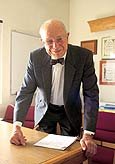 Allen (Jack) Latham Jr. died in August, 2003, at the age of 95. He is most famous for creating, in 1968, an inexpensive plastic chamber for the separation of whole blood into its components. Importantly, the Latham bowl was disposable, eliminating the need to sterilize separation equipment. This technology was brought to market by Haemonetics Corp., a highly successful company founded
Allen (Jack) Latham Jr. died in August, 2003, at the age of 95. He is most famous for creating, in 1968, an inexpensive plastic chamber for the separation of whole blood into its components. Importantly, the Latham bowl was disposable, eliminating the need to sterilize separation equipment. This technology was brought to market by Haemonetics Corp., a highly successful company foundedby Latham in 1971. His connection to the Center for Blood Research began in the early
1950s, when he worked with CBR founder Edwin J. Cohn to improve a blood separation
centrifuge developed by Cohn. According to Dr. Harriet Latham Robinson, a CBR overseer, her father grew up on a farm and was perhaps inspired by milk separation equipment.
The Haemonetics 30 was the introduction to cell separation for a generation of hematologists. I bought my first machine in 1974 - the 9th machine in the world. It cost about £9000 - a lot of money in 1974. I was able to buy it because we had a laundry strike at the hospital. The Chairman of the Medical Board rang me up with teh message that the hospital had unspent money. Laundry workers wages had not been paid because they were on strike, and paper sheets had been far cheaper than their wages. If the money was not spent we would have to return it to the Department of Health, and we would get less the following year.
When I told him that I needed a machine costing £9000 he replied that no individual item could cost more than £1000. So I arranged for the company to sell me 10 machine parts for sums between £900 and £1000.
Haemonetics said that they would do better than that, they would not only sell me the parts, but they would assemble them on the spot free of charge.
Thus I began a career in cell separation that would see me as President of the European Society for Haemapheresis in 1986. But by then I was beginning to drop out of the field. I had been one of the first to investigate plasmapheresis as a treatment for immune diseases, and one of the first to use stem cells derived from peripheral blood as a source for autografting. Now I was becoming an expert in the myelodysplastic syndrome instead.
No comments:
Post a Comment